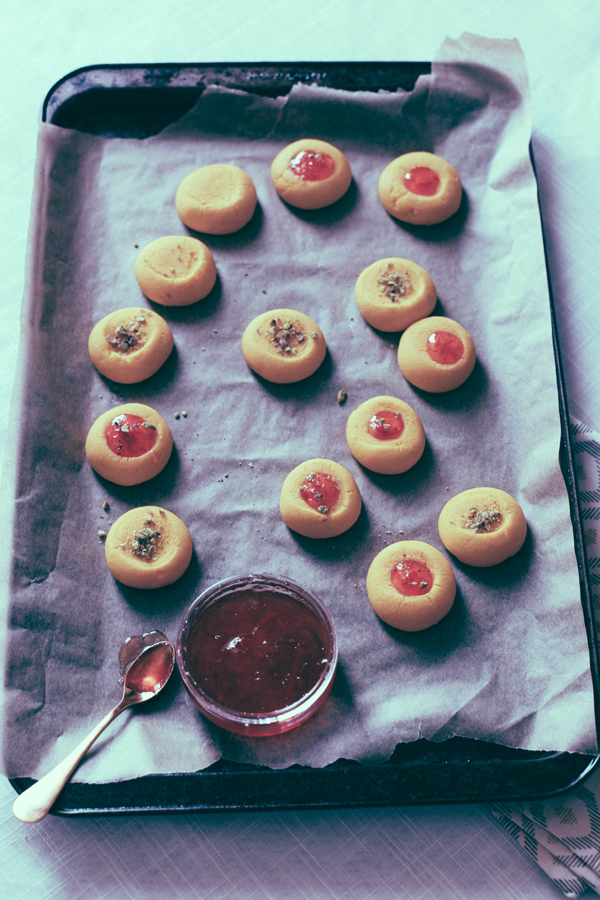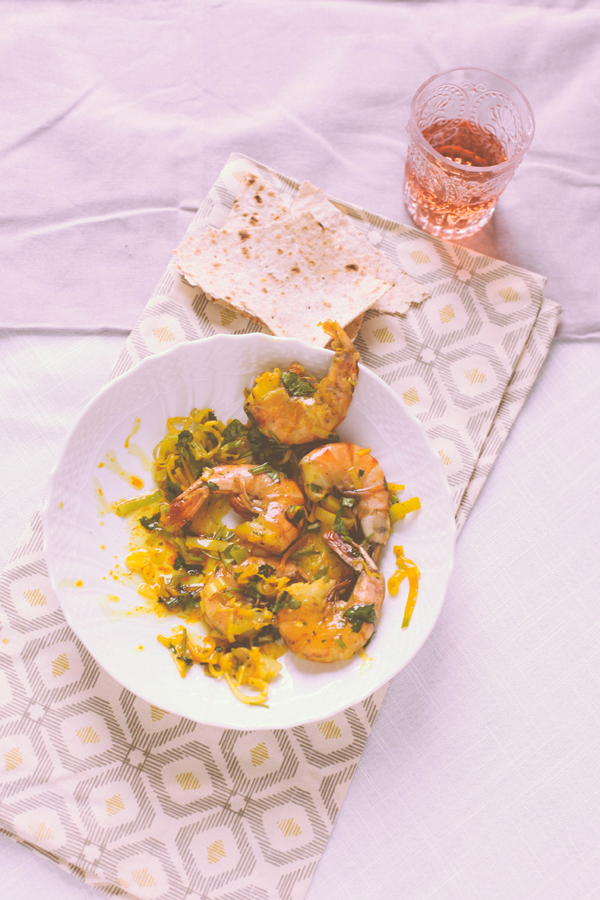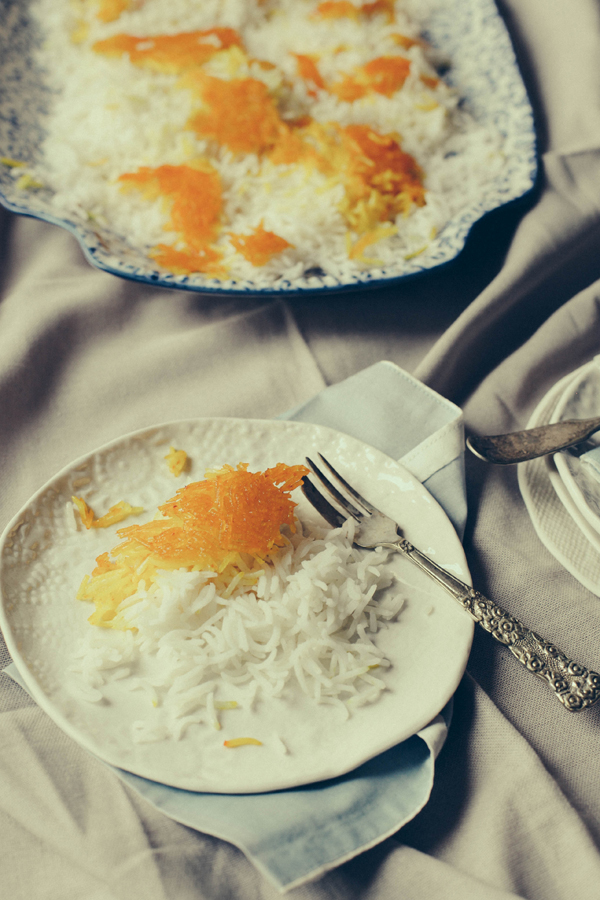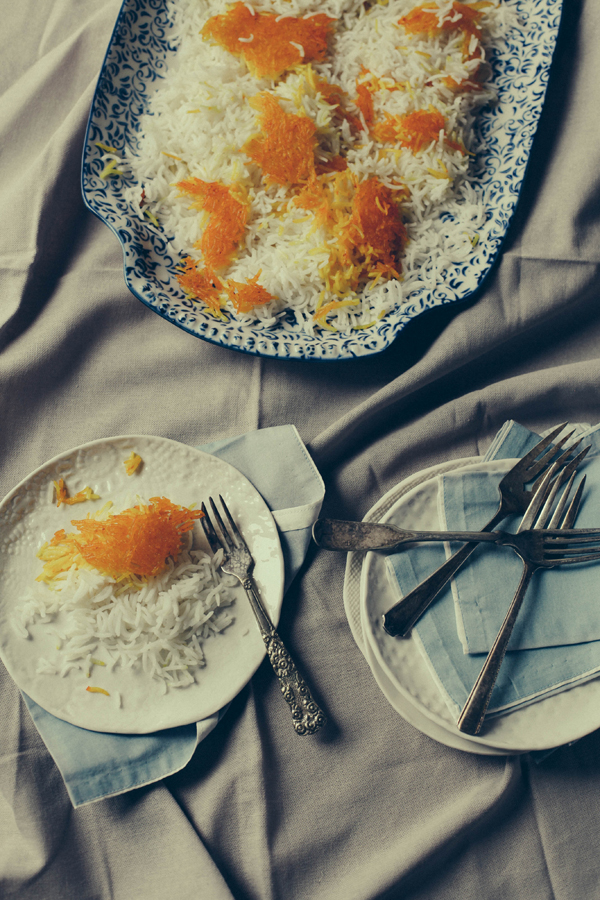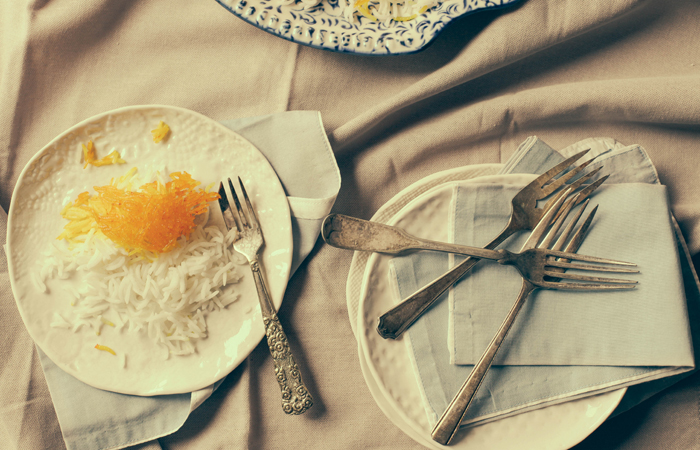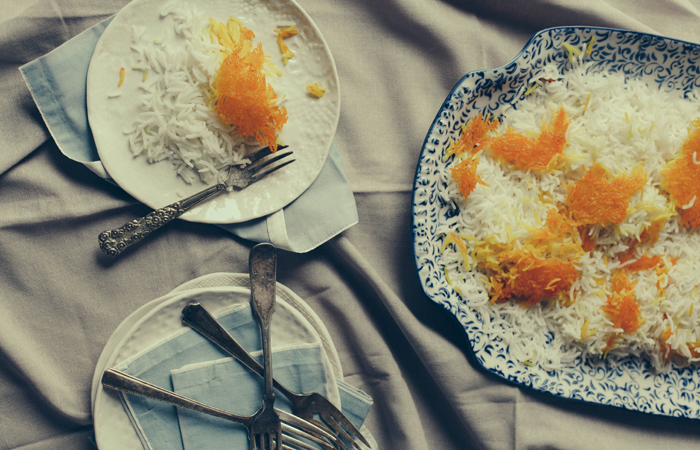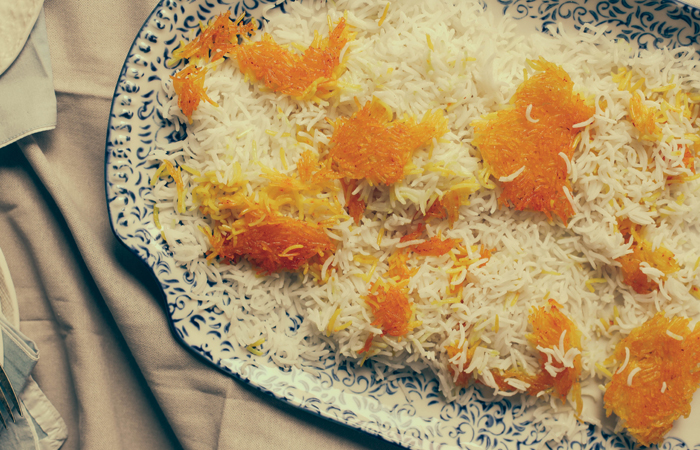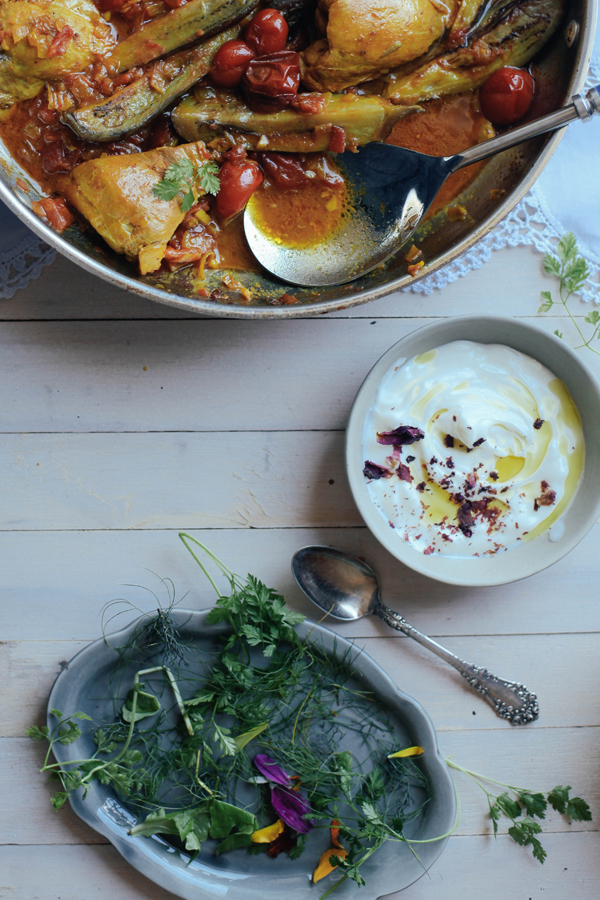
Mehregan Mubarik! Today, along with thirty other Persian food bloggers, we are celebrating Jashn-e-Mehregan – the ancient Persian festival to celebrate the Autumn Equinox. Historically, in ancient Persia, this festival was an occasion to honour the god of justice – Mehr – and to give thanks for the end of the harvest season.
The first thing I think about when the leaves turn ruby-red and my shawls come out of the hidden part of my closet, is a hearty tomato-spiced stew. Now that the days are shorter and we are beginning to spend more time indoors, the scent of saffron, mingling with tomatoes and cumin, bubbling away on the burner, seems to be the best way to spend a night in. Aubergine, with its glorious shades of violet is in season right now and one of my favourite ways of preparing it is to incorporate it into a khoresht; a stew. With its jammy tomato base, all you need to have with this Khoresht-e-Badejmaan is a tahdig – saffron-crusted basmati rice – and creamy strained yoghurt. It seems to be the best way to start a new season and to give thanks for all that we have.
Speaking of giving thanks – I recently became a Canadian citizen and I couldn’t be prouder to be a part of this country – a country which this Pakistani-Persian-Afghan nomad now calls home.
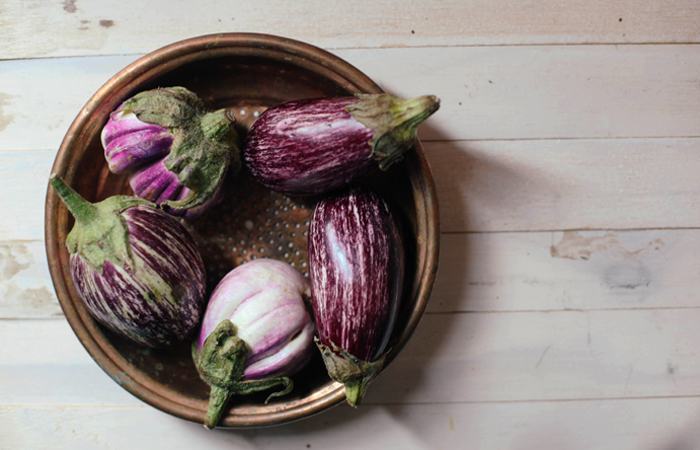
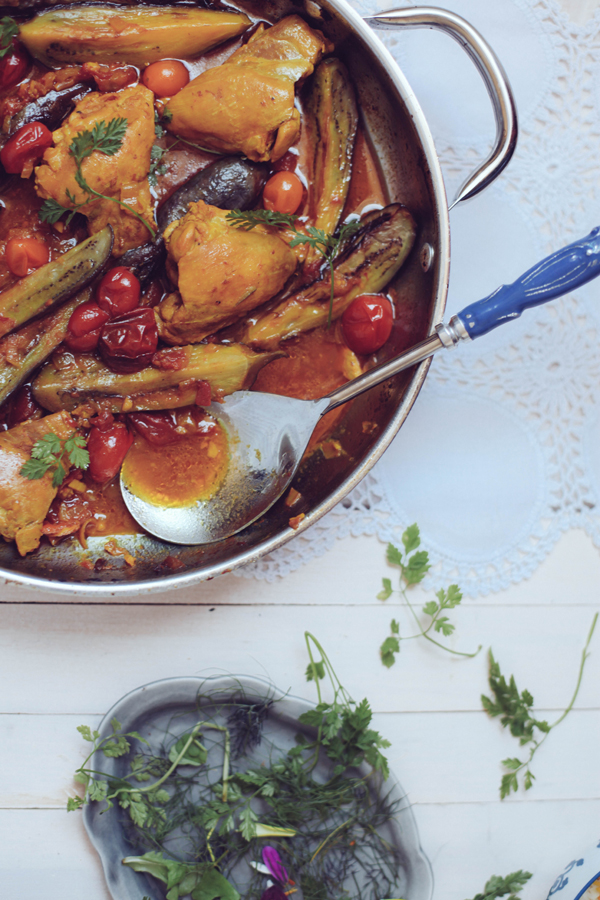
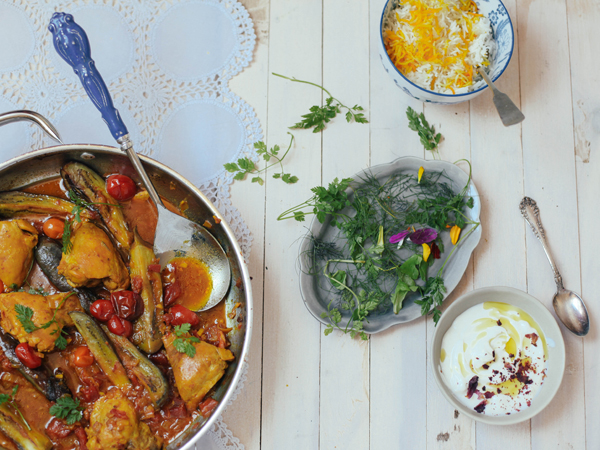
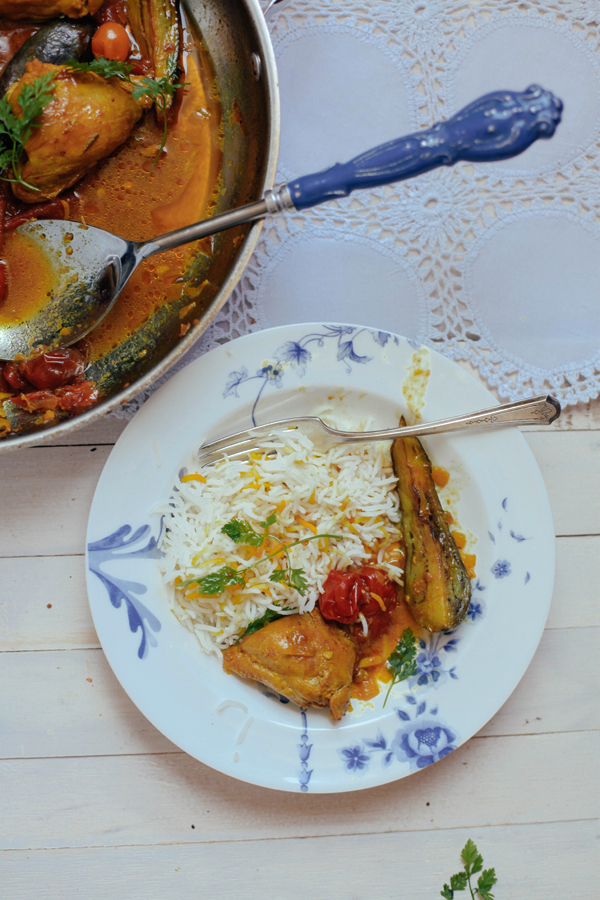
Before you get to my recipe below, I hope you enjoy reading all the beautiful dishes my fellow Persian food bloggers have put together for Mehregan.
Ahu Eats: Badoom Sookhte Torsh | Sour Caramelized Almonds
All Kinds of Yum: Jeweled Carrot Salad
Bottom of the Pot: Broccoli Koo Koo (Frittata)
Cafe Leilee: Northern Iranian Pomegranate Garlic and Chicken Stew
Coco in the Kitchen: Zeytoon Parvardeh | Marinated Olives with Pomegranate & Walnuts
Della Cucina Povera: Ghormeh Sabzi | Persian Lamb & Herb Stew
Fae’s Twist & Tango: Rice Meatballs | Kufteh Berenji
Family Spice: Khoreshteh Kadoo | Butternut Squash Stew
Fig & Quince: Festive Persian Noodle Rice & Roasted Chicken Stuffed with Yummies for Mehregan
Honest and Tasty: Loobia Polo | Beef and Green Bean Rice
Lab Noon: Adas Polo Risotto | Persian Lentils Risotto
Lucid Food: Sambuseh
My Caldron: Anaar-Daneh Mosamma | Pomegranate Stew
My Persian Kitchen: Keshmesh Polow | Persian Raisin Rice
Noghlemey: Parsi Dal Rice Pie
Parisa’s Kitchen: Morasa Polow | Jeweled Rice
Sabzi: Ash-e Mast (Yogurt soup with meatballs)
The Saffron Tales: Khorosht-e Gheimeh | Yellow Lentils Stew
Simi’s Kitchen: Lita Turshisi | Torshi-e Liteh | Tangy aubergine pickle
Spice Spoon: Khoresht-e-bademjaan | Saffron-Scented Aubergine Stew
Turmeric & Saffron: Ash-a Haft Daneh | Seven Bean Soup
The Unmanly Chef: Baghali Polow ba Mahicheh | Rice with Fave Beans and Lamb
ZoZoBaking: Masghati | Persian Scented Starch Fudge
Recipe notes:
• I like this stew with a thick, reduced sauce, if you prefer your stew to be more fluid, with abundant sauce, simply add more water when you add the aubergine in the end.
• Always adjust for salt, because it really depends on your taste as well as the type of salt you are using.
• I prefer chicken with bone because it makes the sauce more flavourful. You can use boneless chicken thighs, too, just remember to decrease the weight to about 700g.
• Feel free to adjust for black and cayenne pepper, as per your preference.
• If you don’t want to broil the aubergine, feel free to gently sauté the flesh side of it in oil, till it is bronzed. I do often use this method, but you have to be quick, because aubergine sucks up a lot of oil when it is sautéed or fried.Ingredients:
*2-3 tbsp olive oil
*125g finely chopped onions (approximately ½ a large onion)
*1 kg chicken thighs (weight with bone)
*2 garlic cloves, minced
*½ tsp turmeric powder
*¼ tsp black pepper
*Pinch cayenne pepper
*¼ tsp cumin powder
*½ + ½ tsp salt
*1 tsp saffron threads, crushed into powder in a pestle and mortar, dissolved with two tablespoons of water
*300g chopped tomatoes, including juices (blanched and skin removed)
*2 tbsp water
*Neutral oil for frying
*350-400g baby aubergine quartered (the slices should be approximately 8-10cm long and 2cm thick)**
*juice of one lime
*1 tsp rose water (optional)***
*8-12 cherry tomatoesPreparation:
*Place a wide heavy-bottomed pan, which has a lid, (the one I use is 30cm in diameter)on the stove on medium heat and add oil. Add onions and sauté for ten minutes, till they become slightly golden, but not brown.*Turn heat to medium-high and add garlic, chicken, turmeric, black pepper, cayenne pepper, cumin, ½ teaspoon salt, saffron water and sauté for five minutes, till the spices are fragrant and the chicken has lost its raw pink colour.
*Add tomatoes, sprinkle with two tablespoons of water, lower the heat to medium and cover the pan for twenty minutes. (If you feel the tomatoes are sticking to the bottom of the pan, add a few more tablespoons of water and lower the heat a bit more.)
*In the meantime, brush the flesh side only of your aubergine with a neutral oil (don’t use olive oil, as it has a low smoking point) and transfer to a baking sheet. Place directly under your broiler (skin side down) and allow the flesh to turn bronze. This will take between five-ten minutes. Keep a vigilant eye on them, they can burn easily.
*Transfer aubergine to the pan at the 20-minute mark, (once the chicken has tenderised), skin side down, and sprinkle with the remaining salt, rosewater and lime juice. If the tomato sauce looks like it has reduced significantly, add more of water. Cover with lid and allow to cook for 25-35 minutes, or till the aubergine is fork tender but still holds its shape.
*When the stew is still hot, before serving, dot the stew with cherry tomatoes, cover with lid and wait till the skin of the tomatoes wilts a bit (five minutes). It adds an extra pop to the dish.
*Serve with your favourite fresh herbs strewn on top, tahdig (saffron-crusted rice) and strained yoghurt.
**You can use any aubergine of your choice, just remember to keep the chopped dimensions in mind.
***Rosewater can be found in Middle Eastern or Pakistani/Indian grocery stores.
